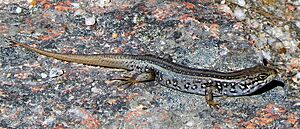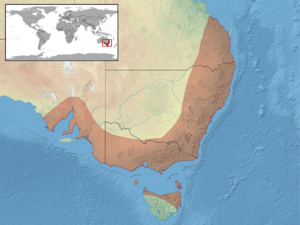White's skink facts for kids
Quick facts for kids White's skink |
|
|---|---|
 |
|
| Conservation status | |
| Scientific classification | |
| Genus: |
Liopholis
|
| Species: |
whitii
|
 |
|
| Synonyms | |
|
|
The White's skink (Liopholis whitii), also known as the White's rock skink, is a type of lizard. It belongs to the family called Scincidae, which includes many different kinds of skinks. This skink is special because it is only found in Australia.
Contents
What's in a Name?
The scientific name for this skink, whitii, was chosen to honor an Irish surgeon and naturalist named John White. He was a very important person in the study of nature.
Where Do White's Skinks Live?
You can find L. whitii in many parts of south-eastern Australia. This includes the island of Tasmania and many smaller islands in the Bass Strait. They are quite widespread across these areas.
Home Sweet Habitat
White's skinks like to live in certain kinds of places. Their favorite natural habitats include forests, areas with lots of shrubland, and rocky spots. You can find them from sea level all the way up to about 1,200 meters (almost 4,000 feet) high.
They especially love places with rocks and heathland, which is a type of shrubby area. They prefer places where people don't disturb the environment too much. These skinks are also good at digging! They make tunnels underground and often create two entrances. This gives them an escape route if a predator tries to catch them. They also hide their tunnel entrances very well.
Meet the White's Skink: Appearance and Diet
The White's skink is a sturdy, medium-sized lizard. It grows slowly, reaching a maximum length of about 90 millimeters (about 3.5 inches) from its snout to the base of its tail. Both male and female skinks are considered grown-up when they reach about 75 millimeters (3 inches) in length. This usually happens when they are about three years old.
White's skinks are omnivores, which means they eat both plants and animals. They can eat meat, insects, and different types of plant material. Sometimes, they even enjoy eating strawberries and raspberries!
Colors and Patterns
These skinks can look quite different from one another in terms of their colors and patterns. Some skinks don't have any pattern on their back, or they might not have stripes around their lips.
Their main body color, especially on the central stripe, can be grey, brown, or even red. The sides of their body often have black and white patterns that look like rosettes. These patterns are set against a background that fades from grey to brown. Their belly is usually a light peachy-orange color. This color gets brighter towards their tail and on the underside of their legs.
On their back, they typically have three stripes. The middle stripe is solid brown. On each side of this, there are two black stripes with white spots. These spots are lined up in a single row and go from the back of their head to the base of their tail. Their head and tail are usually brown with very little pattern.
Most White's skinks have black stripes on both sides of their lips. These stripes start from their yellow-lined eyes and go down to some random spots on their chin. However, every skink has unique lip patterns, and some don't have any stripes at all!
Skink Social Life
L. whitii are burrowing animals, meaning they dig or reuse complex tunnels. They are also a polygynous species. This means one male skink will live with a group of females. They often live in small family groups, which can sometimes be temporary. A group might have up to five females living with one male. However, sometimes the females will mate with males from outside their group.
These skinks can be quite protective of their group. They might act unfriendly towards other skinks they don't know or "like" based on their scent. This can include other female skinks that the group might otherwise accept. This makes it tricky to introduce new skinks to a group. Adult skinks might also chase away or harm young skinks they don't recognize, sometimes even biting their tails.
Life Cycle and Reproduction
White's skinks are viviparous, which means the females give birth to live young instead of laying eggs. Females usually mate in September or October. They then give birth to their babies in late January or February. The birth process can take anywhere from two to ten days. A female skink will typically have a litter of one to four babies.
The baby skinks are quite feisty right from the start! They might even try to chase away other young skinks they see as rivals from their group. Young skinks usually stay with their family for protection until they are about half the size of an adult. At this point, the adult skinks will often chase the young skink out of the group by acting unfriendly towards it.
Different Types of White's Skinks
Scientists recognize two main types, or subspecies, of White's skink. These include the main type, which is called the nominotypical subspecies.
- Egernia whitii moniligera (A.M.C. Duméril & Bibron, 1839)
- Egernia whitii whitii (Lacèpėde, 1804)


